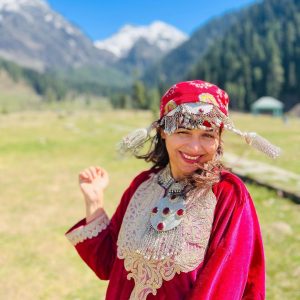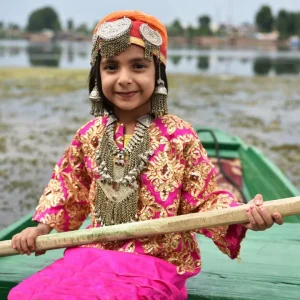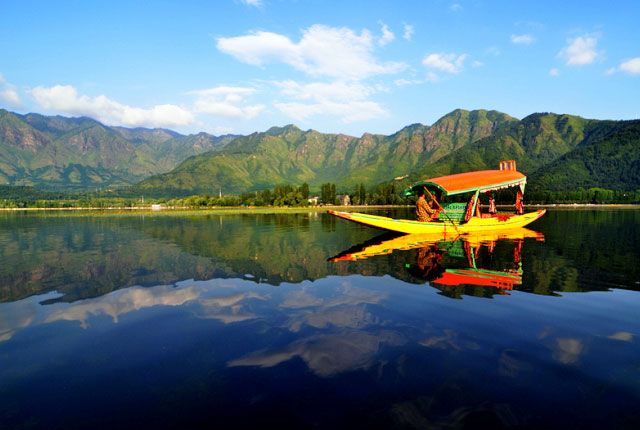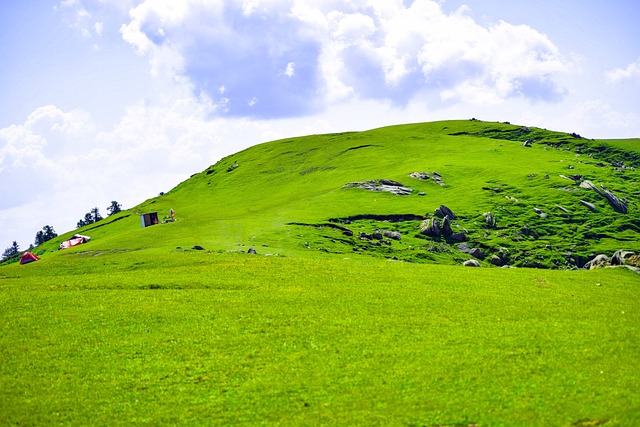
Dress in Kashmir
Table of Contents
ToggleOverview
Kashmir is a place of breathtaking beauty, rich history, and vibrant culture, but also known for its unique approach to fashion. The clothing traditions of Kashmir, influenced by the harsh terrain and the diverse cultural tapestry of the region, are as intricate and elegant as its natural beauty. The region has clothing that comes together with function and artistic merit, making dresses not only effective but also related to the personalities of its peoples. In these elaborative notes, we trace the traditional dresses in Kashmir from the past history, their use, and transformation into modern, contemporary fashion which is now followed in this captivating region.




The Tradition Kashmiri: A Rich Culture
The dress culture of Kashmir depicts the history, geography, and social norms of the region. The attire of the Kashmiri people is fashioned to meet the challenges of one of the extreme climates in the world while depicting centuries of cultural, religious, and artistic influences.
The Pheran: A Symbol of Kashmiri Identity
Arguably the most iconic piece of Kashmiri clothing, the pheran is a long loose robe that both men and women wear. The garment is designed with warming and comfort in mind during the region’s harsh winters. Primarily made out of wool, it is not just a piece of clothing; it is a cultural statement and a vital part of everyday life in Kashmir. The loose-fitting nature of the clothing safeguards the wearers from the biting cold, and the life and resilience of the piece make it a very practical-yet-beautiful option for the people of the region.
Materials Applied in Making Pheran
Pashmina, the famous wool from Kashmir, is applied not only in making shawls but also in creating clothes like pherans. The Pashmina wool is obtained from the undercoat of Himalayan goats. Extremely warm and soft, the wool along with numerous other materials, like silk and cotton, provides this feel of embroidery in pheran. Due to expertise of Kashmiris over artisanal skills, craft of embroidery into intricate patterns usually involved the practice of this type of pheran, a product of design having cultural worth very highly placed in it.
Craft of Pheran Embroidery
The two most popular hand-stitched embroidery techniques in Kashmiri dress are Kashida and Sozni, and embroidery plays a central role in Kashmiri dress. All this occurs over hours-or even months-of meticulous work. The designs inspiration actually lies in the natural surroundings; floral motifs, paisleys, and geometric patterns constitute a lot of work. Thus, the difference between Kashida and Sozni is that Kashida are very fine stitches, wherein a fine needle is used to stitch coloured threads onto the fabric, whereas sozni uses such intricate designs like needle-point.
These breathtaking patterns add so much beauty that are not merely clothes. It is, as a matter of fact, an art piece reflecting the Kashmiri artistry and the skillfulness of the piece with every stitch telling some story of the place’s art history.
The Kashmiri Shawl: A Legacy of Luxury
The most famous export from Kashmir is the Pashmina shawl. Pashmina shawls are among the finest and most luxurious garments in the world, made from centuries-old finest wool collected from the Cashmere goat. Royalty, nobility, and commoners have woven these shawls around them for centuries. What gives a beauty to the Kashmiri shawls is not only the material but also the intricacies in handwoven patterns and artistry involved in making them.
The Pashmina Shawl: A Vogue of Prestige
The Pashmina shawl is obtained from the delicate and soft wool spun by the Pashmina goat, native to the mountainous regions of Kashmir. The wool is very smooth and warm, which provides the utmost comfort during the bitter winters. It is not just an accessory but is a symbol of richness, status, and luxury. It was historically a treasured possession by the royal people and even today it is considered to be one of the finest and costliest textiles in the world.
Techniques and Patterns of Kashmiri Shawls
The artistry in Kashmiri shawls is based on techniques passed from generations. Among the most famous varieties are the Kani shawls and Jamawar shawls. The Kani shawl is created by hand using wooden sticks called “Kani.” It creates colors that are highly detailed, yet intricate. The Jamawar shawl is marked by beautiful brocade work that represents the Kashmiri craftsmanship.
There are also symbolic and non-symbolic kinds of shawls, aside from that nature symbolic patterns of flowers, paisley, and geometric. Months are spent in the work on these shawls, and its price will vary with the intricacy of the design and the quality of wool used.
The Cultural Significance of the Kashmiri Shawl
The Kashmiri shawl is a part of the clothing of the region and is part of the very cultural fabric of the place. It has been passed down from generation to generation as an heirloom. For most Kashmiri women, during marriages, major festivals, and other significant occasions, these shawls form an essential addition to their overall style.
The Kurta and Salwar: Traditional yet Changing Style
In addition to the pheran, a long tunic called the kurta is worn with salwar-loose-fitting trousers or churidar-tight-fitting trousers. The traditional attire is common both in informal and formal settings.
Fabrics and Embroidery of the Kurta and Salwar
The fine silk, wool, or cotton kurtas have beautiful embroidery on the neckline, along the sleeves and hemline. The Kashida embroidery technique is more prominently used for the tunic. Main motifs are flowers, leaves, and geometric patterns.
The salwar or churidar is generally worn along with the kurta that is quite comfortable and elegant. The kurta is, then again covered with a shawl or scarf in case of more formal occasions and thus carries a touch of royalty.
Influence of Geography on Kashmiri Dress
The Kashmiri Dress for Harsh Winters
The climatic conditions in Kashmir, cold climatic, mountainous and extreme cold, have thus largely decided its dress code. Pheran, Pashmina shawls, and woolen garments are intended to protect the body from this extreme cold. Winter seasons here are relatively very long, and people survived such a severe climatic condition for thousands of years only because of their dresses.
Kangri is another item worn to make the person warm, mainly when it reaches the winter months as the device produces some kind of warmness. Such kangris are carried by people under their pherans or jackets for them to keep warm close to their body parts. It has been part and parcel of the Kashmiri life for decades in this particular geographical region.
Kashmiri Dress on Special Occasions or Weddings
The Bridal Attire of Kashmir: A Grand Affair
Kashmiri marriages have tradition written all over them, with flamboyant ceremonies, rituals, and grand celebrations. Costumes used during these ceremonies are no less than grandeur and opulence, as the bride and groom wear appropriate attires for this wedding occasion.
Kashmiri Women’s Wedding Dresses
For the bride, it is an elaborately embroidered garment like Firan that usually allows heavy woolen trousers. Pashmina shawls and a highly intricate headpiece called the Kalgi often accompany it. The bride’s dressing is characterized by much embroidery-in fine kashida and sozni on the Firan. The jewelry is very liberal and often in the forms of gold, silver, and precious stones that adorn the wedding garments.
Groom’s Attire
Traditionally, grooms don a Pheran or Sherwani with Churidar or Shalwar. Many times, grooms add Pashmina shawls or Kashmiri headpieces as an additional flourish to the regalia for the event.
Evolution of Kashmiri fashion over time- Heritage Fusions with Contemporary Fashions
The globalization and influx of various international fashion trends have changed Kashmiri fashion more than ever before. Today, many contemporary Kashmiri women and men are incorporating traditional elements with modern styles, creating a fusion of old and new.
For instance, pheran is reborn with a modern twist through slimmer cuts and contemporary embroidery that appeals to the younger generation. Women can wear their Kashmiri kurtas with jeans or trousers and men can sport Kashmiri shawls as accessories in their casual wardrobes.
Influence of Global Fashion
Once this happens, traditional Kashmiri clothes and fabric will reach international markets, and now these clothes being indigenous to Kashmir from the best designers and fashion freaks of the world became a goldmine of quality as well as beauty, so, the international and local fashion houses collaborated with each other.
Sustainable Fashion in Kashmir
The increasing attention to sustainability and ethics in the fashion world has further positioned Kashmiri dress at the center stage of the international clothing sector. Kashmiri fabrics, especially Pashmina shawls, are considered fashionable alternatives to the large production of synthetic clothes.
The painstakingly slow process of hand-weaving Pashmina wool, coupled with the region’s tradition of artisanal craftsmanship, fits perfectly into the ethos of sustainability. As the fashion world increasingly embraces eco-friendly production, Kashmiri attire, with its slow-fashion heritage, is likely to gain even more prominence.
Conclusion
Kashmi is a complete embodiment of history, craftsmanship, and modernity combined. Whether it is Pheran from thousands of years or the luxuriant shawl of Pashmina, each garment bears witness to cultural identity, artistic sensibilities, and the difficult climatic conditions of the place, which shaped this attire for a long period of time. Traditional attire will, however be still deeply etched in Kashmir’s identity though there is also modern influence coming to Kashmiri dressing.
The beauty of the Kashmiri dress with its artisanal roots and intricate craftsmanship has always been a hallmark of beauty and elegance, speaking to the cultural heritage in a world that’s embracing sustainable fashion.
How to book Kashmir tour?
Contact a travel agency that specializes in Kashmir tours. You can reach out to the following for assistance:
- Phone:
- +91 7889 655596
- +91 7006 891267
- Email:
Inquire about tour packages, itineraries, and pricing, and confirm your booking for a memorable winter experience!
People Also Ask
What is the traditional dress of Kashmir?
The traditional dress of Kashmir is the pheran, a long, loose robe worn by both men and women. It is designed to protect from the cold and is often made from wool or Pashmina fabric. The pheran is usually adorned with intricate embroidery that reflects Kashmiri artistry.
What is the significance of the pheran in Kashmiri culture?
The pheran is more than just clothing in Kashmir; it represents the region’s cultural heritage. Worn to protect against the harsh winter, it also showcases the region’s craftsmanship through intricate embroidery and design, making it a symbol of both tradition and practicality.
What materials are used to make Kashmiri dress?
Kashmiri dress is made from various materials, including wool, cotton, silk, and Pashmina. Wool and Pashmina are especially significant because they provide warmth during the cold winters, while silk is often used for elegant occasions.
What is a Pashmina shawl?
A Pashmina shawl is a luxurious garment woven from the fine wool of the Pashmina goat native to the Kashmir region. It is renowned for its softness, warmth, and high quality, often adorned with intricate designs and embroidery.
Why are Pashmina shawls so expensive?
Pashmina shawls are expensive due to the labor-intensive process of weaving them by hand, the rarity of Pashmina wool, and the intricate craftsmanship involved. High-quality Pashmina shawls can take months to complete, contributing to their value.
What is Kashida embroidery?
Kashida is a traditional form of Kashmiri embroidery that uses fine silk threads to create intricate floral and geometric designs. It is often applied to shawls, pherans, and other garments, enhancing their beauty and cultural significance.
What is Sozni embroidery?
Sozni embroidery is another fine Kashmiri technique that involves delicate needlework. It is known for its intricate, detailed, and often symmetrical designs, typically found on woolen garments like pherans and shawls.
What is a Kani shawl?
A Kani shawl is a type of handwoven shawl from Kashmir made using Kani, wooden sticks that help create intricate, colorful patterns. These shawls are considered highly valuable and are known for their detailed craftsmanship and rich patterns.
What are the modern styles of Kashmiri dress?
Modern Kashmiri dress combines traditional elements with contemporary styles. For example, the pheran has been reimagined in slimmer cuts, and the traditional shawl can be paired with Western-style outfits, offering a fusion of old and new.
How do men wear traditional Kashmiri clothing?
Kashmiri men traditionally wear a pheran, kurta, and shalwar. The attire is usually simple, but can be adorned with embroidered details, particularly on the collar or sleeves. They may also wear Pashmina shawls and fez hats as accessories.
What role does Kashmiri embroidery play in clothing?
Kashmiri embroidery adds cultural and aesthetic value to garments. It transforms basic attire like pherans and shawls into intricate, artful pieces that showcase Kashmir’s rich artistic tradition and craftsmanship.
What is the significance of Kashmiri shawls in weddings?
Kashmiri shawls, particularly Pashmina shawls, hold great importance in weddings. They are worn by brides to add elegance to their attire and are often passed down through generations as family heirlooms.
How is Kashmiri fashion influenced by climate?
Kashmir’s cold climate significantly influences its fashion. Garments like the pheran and Pashmina shawls are designed to offer warmth and comfort during the region’s bitter winters, while still reflecting the region’s aesthetic values.
What is the difference between a Pashmina shawl and a regular wool shawl?
The difference lies in the quality of the wool used. Pashmina wool is finer, softer, and more luxurious than regular wool. Pashmina shawls are handwoven with intricate designs, whereas regular wool shawls tend to be simpler.
How do you wear a Kashmiri pheran?
To wear a Kashmiri pheran, simply slip the loose garment over your head. It is traditionally worn over lighter clothing like a kurta and can be layered with Pashmina shawls for additional warmth.
What is the role of jewelry in Kashmiri dress?
Jewelry plays an important role in completing traditional Kashmiri outfits. Women wear trinkets (headpieces) and kalgi (hair ornaments) during weddings and special occasions, while men may wear traditional fez hats or caps.
Are Kashmiri clothes suitable for everyday wear?
Yes, many Kashmiri garments, like the pheran and the kurta, are worn as everyday attire, especially during the winter months. The practicality of the pheran makes it an ideal everyday garment for keeping warm.
What is the modern fusion of Kashmiri and Western styles?
In modern fashion, the fusion of Kashmiri and Western styles has become common. For example, Kashmiri kurtas are often paired with jeans or trousers, and Pashmina shawls are worn with both casual and formal outfits, blending traditional designs with contemporary looks.
What is a traditional Kashmiri wedding dress?
A traditional Kashmiri bridal dress often includes an embroidered pheran, Pashmina shawls, and ornate jewelry. The attire is complemented by kalgi and trinkets for the bride, making the wedding outfit both regal and culturally significant.
How are Kashmiri shawls woven?
Kashmiri shawls are woven using traditional handloom techniques, often involving months of painstaking work. The process includes spinning the wool, dyeing it, and weaving it into complex patterns using wooden looms, particularly for shawls like the Kani shawl.
What is the history behind the Pashmina shawl?
The Pashmina shawl has a long history, dating back to the Mughal era. It was once a luxurious garment worn by royalty and aristocracy. The techniques of weaving and embroidering these shawls were passed down through generations, establishing Kashmir as a global center for high-quality textiles.
How can I tell if a Pashmina shawl is authentic?
To determine the authenticity of a Pashmina shawl, you should check its texture (Pashmina wool feels incredibly soft), its lightness, and its ability to be twisted into a small bundle. Additionally, authentic Pashmina shawls often have intricate handwoven patterns.
Why is Kashmiri embroidery so unique?
Kashmiri embroidery is unique because it is done entirely by hand using traditional techniques like Kashida and Sozni. The designs are often inspired by nature, with floral, paisley, and geometric motifs, making each piece of clothing or accessory a work of art.
What are modern trends in Kashmiri clothing?
Modern trends in Kashmiri clothing include a shift toward more contemporary designs, with traditional pherans being tailored to fit modern silhouettes. The rise of fusion styles, where Kashmiri garments are paired with Western attire, is also growing in popularity.
How long does it take to make a Pashmina shawl?
It can take several months to make a Pashmina shawl due to the intricate hand-weaving and embroidery process. The time taken depends on the complexity of the design and the quality of the Pashmina wool used.
Are Kashmiri dresses worn only in Kashmir?
While Kashmiri dresses are most commonly worn in Kashmir, the beauty and craftsmanship of the garments have attracted attention worldwide. Kashmiri dresses are worn globally, especially during colder months and by those who appreciate traditional textiles.
What is the best time to buy Kashmiri dresses?
The best time to buy Kashmiri dresses is during the winter months when they are in high demand due to the colder climate. Additionally, buying during festivals like Eid or Diwali may give you access to exclusive collections, as many artisans and stores offer seasonal discounts.
What makes Kashmiri Pashmina shawls so special?
Kashmiri Pashmina shawls are known for their softness, warmth, and lightweight nature. They are handwoven with care, making them not only functional but also luxurious. The natural fibers used in these shawls make them more durable and exquisite compared to other shawls.
Can Kashmiri clothing be worn year-round?
While Kashmiri clothing, such as the pheran and shawls, is often associated with cold weather, lighter versions of these garments can be worn year-round. The Pashmina shawl, for example, is light enough to be worn during cooler summer evenings, making it versatile.
How do Kashmiri dresses reflect the culture of the region?
Kashmiri dresses reflect the culture of the region through their materials, intricate craftsmanship, and the use of traditional techniques. Clothing like pherans, Pashmina shawls, and Kashida embroidery are deeply rooted in the heritage of Kashmir, showcasing the region’s natural beauty and cultural identity.




